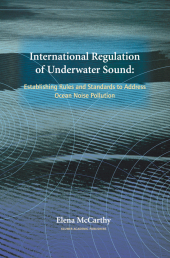 Neuerscheinungen 2010Stand: 2020-01-07 |
Schnellsuche
ISBN/Stichwort/Autor
|
Herderstraße 10
10625 Berlin
Tel.: 030 315 714 16
Fax 030 315 714 14
info@buchspektrum.de |

Elena McCarthy
International Regulation of Underwater Sound
Establishing Rules and Standards to Address Ocean Noise Pollution
Softcover reprint of the original 1st ed. 2004. 2010. xii, 287 S. 34 SW-Abb.,. 235 mm
Verlag/Jahr: SPRINGER, BERLIN 2010
ISBN: 1-441-95469-4 (1441954694)
Neue ISBN: 978-1-441-95469-5 (9781441954695)
Preis und Lieferzeit: Bitte klicken
Numerous incidents suggest that man-made sound injures and can kill marine mammals. This book offers an objective look at how ocean noise should be addressed given the lack of regulatory structure and the scientific uncertainty over the effects of noise on marine life. It is an essential text for policymakers, governments and NGOs, biologists, environmental activists, , oceanographers, and those in the shipping, engineering, and offshore oil and gas industries.
Chapter One - Introduction
1. A Brief History of the Use of Sound in the Ocean
2. Ambient Noise in the Sea
3 Effects of Sound on Marine Mammals
4. Regulation of Noise in the Ocean-Some Background
Chapter Two - Scientific Aspects of Underwater Sound
1. The Physics of Underwater Sound
2. Effects of Acoustic Emissions
2.1 Health Threats to Marine Mammals
2.2 Health Threats to Humans
2.3 Threats to other Marine Life
2.4 Acoustic Interference
3. Summary - Effects of Acoustic Emissions
4. Sources of Naturally-Occurring Sound in the Ocean
4.1 Physical and Geophysical Sources
4.2 Biological Sources
4.3 Sounds from Marine Mammals
5. Anthropogenic Sound in the Sea
5.1 Is Ambient Noise Increasing?
5.2 The Many Uses of Sonar
5.3 Shipping and Shipping Trends
5.4 Dredging and Coastal Construction
5.5 Offshore Oil and Mineral Exploration
5.6 Recreational Boating
5.7 Fishing and Aquaculture
5.8 Military Activities
5.9 Oceanographic Research
5.10 Other Sources
5.11 Ambient Noise Summary
6. Hotspots - Sensitive Areas of Intense Acoustic Activity
6.1 Stellwagen Bank
6.2 The Ligurian Sea
6.3 Other Hotspots
Chapter Three - Focusing Events
1. What are Focusing Events?
2. The Role of Non-Governmental Organizations
2.1 What are Environmental NGOs?
2.2 Public Perception of Marine Mammals
2.3 The Natural Resources Defense Council
2.4 Other NGOs involved in Ocean Noise Pollution
2.5 The Emergence of New NGOs
3. Key Focusing Events
3.1 Ship Shock Testing
3.2 Acoustic Thermometry of Ocean Climate (ATOC)
3.3 The North Pacific Acoustic Laboratory (NPAL)
3.4 Greek Whale Strandings and NATO
3.5 Surveillance Towed Array Sensor System (SURTASS)
3.6 Bahamas Strandings
3.7 Littoral Warfare Advanced Development (LWAD)
3.8 Other Focusing Events
4. Other Factors Contributing to the Noise Controversy
Chapter Four - Policy Development
1. Trail Smelter and Regulation of Transboundary Pollutants
2. The Pollution Provisions of the Law of the Sea Convention
3. Ocean Noise as a Transbounday Pollutant
4. Previous Regulation of Transboundary Pollutants
4.1 Thermal Ocean Pollution
4.2 Radiation
4.3 Air Pollution
5. Existing International Regulatory Framework
5.1 The United Nations Environmental Programme
5.2 The International Maritime Organization
5.3 International Whaling Commission
5.4 International Seabed Authority
5.5 The European Union
5.6 The Use of Regional Agreements
5.6.1 The OSPAR Convention
5.6.2 The Arctic Council
5.6.3 ASCOBANS
5.6.4 ACCOBAMS
5.6.5 NATO
Chapter Five - Politics, Potential Solutions, and Obstacles
1. International Institutions
1.1 The Value of International Regimes and Organizations
1.2 GESAMP
1.3 The Development of an International Treaty
2. Conventional Approaches to Pollution Control
3. Policy Instruments for Addressing Ocean Noise Pollution
3.1 Taxes
3.2 Performance Bonds and Subsidies
3.3 Permits
3.4 Technological Standards- BAT and BPT
3.5 Best Practicable Environmental Option
3.6 Bans and Zoning
3.7 Marine Protected Areas
4. The Trend Toward Ecosystem Based Ocean Management
5. Policy Instruments - A Summary
Chapter Six - The Use Of Marine Protected Areas
1. Unilateral MPAS in the U.S. and Abroad
2. Multilateral MPAs
3. The Potential of MPAs to Prevent Acoustic Disturbance
4. Zoning in MPAs
4.1 Activity-Specific Zones
4.2 Individual Source-Specific Zones
4.3 Buffer Zones
5. Challenges in Implementing MPAs and Zoning
Chapter 7 - Conclusion
1. The Politics of Policy-Making
1.1 Where is the Issue of Ocean Noise?
1.2 Incrementalism and Public Policy
2. Summary of Findings
Appendix A - Glossary
Appendix B - List of Acronyms
Bibliography


